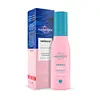What's inside
What's inside
 Key Ingredients
Key Ingredients

 Benefits
Benefits

 Concerns
Concerns

 Ingredients Side-by-side
Ingredients Side-by-side

Water
Skin ConditioningGlycerin
HumectantCaprylic/Capric Triglyceride
MaskingIsopropyl Myristate
EmollientNiacinamide
SmoothingGlyceryl Stearate Citrate
EmollientPentaerythrityl Distearate
EmulsifyingPhenoxyethanol
PreservativeAmmonium Polyacryloyldimethyl Taurate
Emulsion StabilisingBehenyl Alcohol
EmollientCitrullus Lanatus Fruit Extract
Skin ConditioningHyaluronic Acid/Polyglutamic Acid Crosspolymer
AntioxidantEthylhexylglycerin
Skin ConditioningTitanium Dioxide
Cosmetic ColorantIsopropyl Palmitate
EmollientGlyceryl Glucoside
HumectantTrisodium Ethylenediamine Disuccinate
Aluminum Hydroxide
EmollientLauric Acid
CleansingCitric Acid
BufferingPentylene Glycol
Skin ConditioningPotassium Sorbate
PreservativeSodium Benzoate
MaskingParfum
MaskingWater, Glycerin, Caprylic/Capric Triglyceride, Isopropyl Myristate, Niacinamide, Glyceryl Stearate Citrate, Pentaerythrityl Distearate, Phenoxyethanol, Ammonium Polyacryloyldimethyl Taurate, Behenyl Alcohol, Citrullus Lanatus Fruit Extract, Hyaluronic Acid/Polyglutamic Acid Crosspolymer, Ethylhexylglycerin, Titanium Dioxide, Isopropyl Palmitate, Glyceryl Glucoside, Trisodium Ethylenediamine Disuccinate, Aluminum Hydroxide, Lauric Acid, Citric Acid, Pentylene Glycol, Potassium Sorbate, Sodium Benzoate, Parfum
Water
Skin ConditioningCyclopentasiloxane
EmollientDimethicone
EmollientPolysilicone-11
Butylene Glycol
HumectantDecyl Glucoside
CleansingHydrogenated Ethylhexyl Olivate
EmollientHydrogenated Olive Oil Unsaponifiables
EmollientCyclohexasiloxane
EmollientCeteareth-20
CleansingGlyceryl Stearate Citrate
EmollientDicaprylyl Carbonate
EmollientCetearyl Alcohol
EmollientCetyl Palmitate
EmollientSorbitan Palmitate
EmulsifyingSorbitan Oleate
EmulsifyingC12-15 Alkyl Benzoate
AntimicrobialGlycerin
HumectantGlyceryl Glucoside
HumectantBehenyl Alcohol
EmollientSodium Polyacryloyldimethyl Taurate
Emulsion StabilisingPhenoxyethanol
PreservativeEthylhexylglycerin
Skin ConditioningOctenidine Hcl
AntimicrobialCeramide NP
Skin ConditioningCeramide AP
Skin ConditioningCeramide EOP
Skin ConditioningPhytosphingosine
Skin ConditioningCholesterol
EmollientSodium Lauroyl Lactylate
EmulsifyingCarbomer
Emulsion StabilisingXanthan Gum
EmulsifyingPolymethylsilsesquioxane
Sodium Hyaluronate Crosspolymer
HumectantTocopherol
AntioxidantDisodium EDTA
Sodium Hydroxide
BufferingWater, Cyclopentasiloxane, Dimethicone, Polysilicone-11, Butylene Glycol, Decyl Glucoside, Hydrogenated Ethylhexyl Olivate, Hydrogenated Olive Oil Unsaponifiables, Cyclohexasiloxane, Ceteareth-20, Glyceryl Stearate Citrate, Dicaprylyl Carbonate, Cetearyl Alcohol, Cetyl Palmitate, Sorbitan Palmitate, Sorbitan Oleate, C12-15 Alkyl Benzoate, Glycerin, Glyceryl Glucoside, Behenyl Alcohol, Sodium Polyacryloyldimethyl Taurate, Phenoxyethanol, Ethylhexylglycerin, Octenidine Hcl, Ceramide NP, Ceramide AP, Ceramide EOP, Phytosphingosine, Cholesterol, Sodium Lauroyl Lactylate, Carbomer, Xanthan Gum, Polymethylsilsesquioxane, Sodium Hyaluronate Crosspolymer, Tocopherol, Disodium EDTA, Sodium Hydroxide
Ingredients Explained
These ingredients are found in both products.
Ingredients higher up in an ingredient list are typically present in a larger amount.
Behenyl Alcohol is a type of fatty alcohol (these are different from the drying, solvent alcohols).
Fatty Alcohols have hydrating properties and are most often used as an emollient or to thicken a product. They are usually derived from natural fats and oils; behenyl alcohol is derived from the fats of vegetable oils.
Emollients help keep your skin soft and hydrated by creating a film that traps moisture in.
In 2000, Behenyl Alcohol was approved by the US as medicine to reduce the duration of cold sores.
Learn more about Behenyl AlcoholEthylhexylglycerin (we can't pronounce this either) is commonly used as a preservative and skin softener. It is derived from glyceryl.
You might see Ethylhexylglycerin often paired with other preservatives such as phenoxyethanol. Ethylhexylglycerin has been found to increase the effectiveness of these other preservatives.
Glycerin is already naturally found in your skin. It helps moisturize and protect your skin.
A study from 2016 found glycerin to be more effective as a humectant than AHAs and hyaluronic acid.
As a humectant, it helps the skin stay hydrated by pulling moisture to your skin. The low molecular weight of glycerin allows it to pull moisture into the deeper layers of your skin.
Hydrated skin improves your skin barrier; Your skin barrier helps protect against irritants and bacteria.
Glycerin has also been found to have antimicrobial and antiviral properties. Due to these properties, glycerin is often used in wound and burn treatments.
In cosmetics, glycerin is usually derived from plants such as soybean or palm. However, it can also be sourced from animals, such as tallow or animal fat.
This ingredient is organic, colorless, odorless, and non-toxic.
Glycerin is the name for this ingredient in American English. British English uses Glycerol/Glycerine.
Learn more about GlycerinGlyceryl Glucoside is made from glycerol and glucose.
It is a humectant. Humectants help hydrate your skin by drawing moisture to it from the air.
Some foods that contain glyceryl glucoside include sake, miso, and wines.
Learn more about Glyceryl GlucosideGlyceryl Stearate Citrate is a citric acid ester of glyceryl stearate.
It is an emulsifier, emollient, and a surfactant.
Emulsifiers help stabilize a product. It does this by preventing certain ingredients from separating. Common ingredients include oils and water, which do not mix naturally. Emulsifiers have properties that help keep ingredients such as these together.
Emollients help soothe and soften the skin. They do this by creating a protective film on your skin. This barrier helps trap moisture and keeps your skin hydrated. Emollients may be effective at treating dry or itchy skin.
Surfactants help gather oils, dirt, and other pollutants from the skin. This helps them to be easily rinsed away.
Learn more about Glyceryl Stearate CitratePhenoxyethanol is a preservative that has germicide, antimicrobial, and aromatic properties. Studies show that phenoxyethanol can prevent microbial growth. By itself, it has a scent that is similar to that of a rose.
It's often used in formulations along with Caprylyl Glycol to preserve the shelf life of products.
Water. It's the most common cosmetic ingredient of all. You'll usually see it at the top of ingredient lists, meaning that it makes up the largest part of the product.
So why is it so popular? Water most often acts as a solvent - this means that it helps dissolve other ingredients into the formulation.
You'll also recognize water as that liquid we all need to stay alive. If you see this, drink a glass of water. Stay hydrated!
Learn more about Water